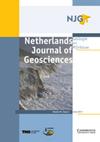荷兰阿默斯福特盆地emian - Early Weichselian区域和局部植被发育及沉积和地貌控制
IF 2.3
2区 地球科学
Q3 GEOSCIENCES, MULTIDISCIPLINARY
Netherlands Journal of Geosciences-Geologie En Mijnbouw
Pub Date : 2022-03-24
DOI:10.1017/njg.2022.4
引用次数: 4
摘要
摘要采用花粉分析方法,对阿默斯福特冰川盆地的两个新记录进行了研究。岩心位于较深的部分,靠近原始的Eemian层型Amersfoort 1 (Zagwijn, 1961)和盆地边缘。目的是重建Eemian和早期Weichselian的植被发育,并探讨适应空间、外来花粉的涌入和地貌对植被组成的影响。将Amersfoort盆地的结果与阿姆斯特丹盆地和荷兰其他Eemian遗址的当前Eemian层型进行了比较。在阿默斯福特盆地深部恢复了一个几乎完整的Eemian - Early Weichselian层序(E2-EWII)。与较深的阿姆斯特丹盆地相比,阿默斯福特盆地没有记录到晚萨利安-早埃米逊过渡。盆地边缘岩心Den Treek显示出晚Eemian (E5-6)和早Weichselian (EW I-II)的浓缩序列,显示出可容纳空间的重要性。Eemian海侵的第一次冲击发生在Amersfoort盆地和Amsterdam盆地的E3 - E4a边界,最高海平面出现在E5花粉带的末端。在埃米恩三角洲上游,古韦赫特河谷和艾塞尔盆地,海侵记录较晚。碎屑沉积物单元中重新加工(异域)花粉的涌入阻碍了LS和Eemian期间的植被和气候重建。碎屑沉积层段E4带云杉和E5带冷杉的早期出现可能与莱茵河的长途搬运和鄂米三角洲的重新分布有关。局部植被发育会使区域生物地层对比复杂化。桤木被认为是Eemian晚期(E5-6)的特征,在Amersfoort盆地的短距离内显示出很大的差异,这与Eemian E3以来当地桤木的生长有关。花粉带E5的诊断值Carpinus在海拔较高、排水良好的冰推脊附近的盆地中值较高,而在低起伏环境中值较低。在阿姆斯特丹和阿默斯福特盆地的E5区,高海平面期间出现了咸水到半咸水的沼泽,而在莱茵河三角洲的上游,咸水到淡水的潮汐条件占主导地位。Zagwijn(1961)认为E6到EWI边界在植被覆盖的第一个开口处被定义,Calluna、Poaceae和Artemisia增加,往往与岩性从有机沉积到碎屑沉积的变化相一致,反映了景观不稳定性的增加。阿默斯福特盆地的岩心显示完整的埃姆期至早期韦切利世记录。建议确定阿默斯福特盆地威奇塞利期基底的边界层型。目前的平流层型阿姆斯特丹航站楼揭示了一个完全发展的LS到Eemian过渡,并包含Eemian阶段基础的边界平流层型。本文章由计算机程序翻译,如有差异,请以英文原文为准。
Eemian to Early Weichselian regional and local vegetation development and sedimentary and geomorphological controls, Amersfoort Basin, The Netherlands
Abstract Two new records from the Amersfoort glacial basin are investigated by means of pollen analysis. The cores are situated in the deeper part, close to the original Eemian stratotype Amersfoort 1 (Zagwijn, 1961) and at the margin of the basin. The aim is to reconstruct the Eemian and Early Weichselian vegetation development and to explore the impact of accommodation space, influx of allochthonous pollen and geomorphology on the vegetation composition. The results of the Amersfoort Basin are compared to the current Eemian stratotype in the Amsterdam Basin and other Eemian sites in the Netherlands. An almost complete Eemian to Early Weichselian sequence (E2-EWII) was retrieved from the deeper part of the Amersfoort basin. The late Saalian (LS) to early Eemian transition is not recorded in the Amersfoort basin, in contrast to the deeper Amsterdam Basin. The basin marginal core Den Treek reveals a condensed late Eemian (E5-6) and Early Weichselian (EW I-II) succession showing the importance of accommodation space. The first impact of the Eemian transgression is registered at the E3 to E4a boundary in the Amersfoort and Amsterdam basins, and highest sea level is proposed at the end of pollen zone E5. Upstream in the Eemian delta, in the palaeo-Vecht valley and IJssel Basin, the transgression is recorded later. The influx of reworked (allochthonous) pollen in clastic sediment units hampers vegetation and climatic reconstructions during the LS and Eemian. The early appearance of Picea in zone E4 and Abies in zone E5 in clastic sediment intervals can be related to long-distance transport by the river Rhine and redistribution in the Eemian delta. Local vegetation development can complicate regional biostratigraphic correlations. Alnus, considered characteristic for the late Eemian (E5-6), shows large differences over short distances in the Amersfoort Basin, related to local alder growth since Eemian E3. Carpinus, diagnostic for pollen zone E5, shows high values in the basins adjacent to higher, well-drained ice-pushed ridges, but low values in low-relief environments. Salt- to brackish-water marshes were present during high sea level in zone E5 in the Amsterdam and Amersfoort basins, while further upstream in the Rhine delta brackish to fresh-water tidal conditions dominated. In line with Zagwijn (1961), the E6 to EWI boundary is defined at the first opening of the vegetation cover with Calluna, Poaceae and Artemisia increase, often coinciding with a lithological change from organic to clastic deposition, reflecting increased landscape instability. The cores from the Amersfoort basin reveal a complete Eemian to Early Weichselian record. It is suggested to define the boundary stratotype for the base of the Weichselian Stage in the Amersfoort Basin. The current stratotype Amsterdam-Terminal reveals a fully developed LS to Eemian transition and contains the boundary stratotype for the base of the Eemian Stage.
求助全文
通过发布文献求助,成功后即可免费获取论文全文。
去求助
来源期刊
CiteScore
4.00
自引率
25.90%
发文量
14
审稿时长
>12 weeks
期刊介绍:
Netherlands Journal of Geosciences - Geologie en Mijnbouw is a fully open access journal which publishes papers on all aspects of geoscience, providing they are of international interest and quality. As the official publication of the ''Netherlands Journal of Geosciences'' Foundation the journal publishes new and significant research in geosciences with a regional focus on the Netherlands, the North Sea region and relevant adjacent areas. A wide range of topics within the geosciences are covered in the journal, including "geology, physical geography, geophyics, (geo-)archeology, paleontology, hydro(geo)logy, hydrocarbon exploration, modelling and visualisation."
The journal is a continuation of Geologie and Mijnbouw (published by the Royal Geological and Mining Society of the Netherlands, KNGMG) and Mededelingen Nederlands Instituut voor Toegepaste Geowetenschappen (published by TNO Geological Survey of the Netherlands). The journal is published in full colour.

 求助内容:
求助内容: 应助结果提醒方式:
应助结果提醒方式:


